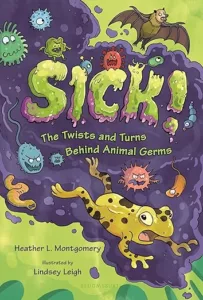Sick!: The Twists and Turns Behind Animal Germs
Heather L. Montgomery
Illustrated by Lindsey Leigh
Bloomsbury USA Children’s
Published February 20, 2024
Amazon | Bookshop | Goodreads
About Sick!
When a super sickness lands on the land, when a parasite becomes more than a pest, when an infection ignites an epidemic, what’s a body to do? Your body is an animal body, so why not ask the animals?
Follow the scientists, around the world and into their labs, who are studying animals and the germs that attack them. From fungus-ridden frogs with fevers to bacteria-resistant buzzards and everything in-between, animals have A LOT to teach us about infections. But-reader beware!!-the story of germs is filled with twists and turns.
In this fascinating, highly visual nonfiction book packed with colorful, comic-style art, you’ll discover not only the cool ways that animal bodies (and our bodies) fight back against pesky pathogens but also the amazing and surprising ways we can learn to work together with germs.
Sick! The Twists and Turns Behind Animal Germs is written by Heather L. Montgomery with graphic novel-style art from Lindsey Leigh.
My Review
The book begins with a note to readers warning them that not all the questions raised in the book have answers. There are lots of mysteries scientists still explore today and lots of things we can only guess at understanding. With my expectations appropriately tailored, I jumped into reading this book– and was hooked on the fascinating facts inside it.
For most of the book, each chapter focuses on one type of animal and the different pests– pathogens and parasites– that attack it. We learn what the animal has done to adapt to the invaders or, in some cases, what we suspect might be happening. From frogs and alligators to chimpanzees and bats, the book explores facts about lots of different types of animals. It also mentions ways in which our discoveries about these animals’ disease-fighting adaptations may be used to create treatments or vaccines for human diseases.
I found this to be super fascinating stuff. Because I read a pre-release, unfinished copy of the book, I couldn’t see a lot of the final illustrations. A few of the sketches that I could see were a little challenging to interpret. I don’t know if any of the artwork I was looking at is final, though, so it could be that the finished images relate information much more clearly.
On the whole, I think this is a great introduction to animals and diseases and how different species interact. It’s very upbeat and fun, so this isn’t something that intends to scare anyone. It’s engaging and definitely the kind of book that could spark a deeper interest in biology or medicine.
Content Notes
Recommended for Ages 10 up.
Representation
The text briefly mentions some scientists of diverse backgrounds.
Profanity/Crude Language Content
References poop, as you might expect in talking about animals and the transmission of parasites or germs.
Romance/Sexual Content
None.
Spiritual Content
None.
Violent Content
Brief descriptions of territorial battles between alligators that leave the loser short a limb and the methods vultures use to get into carrion. Some brief descriptions of the ways germs and parasites destroy their hosts.
Drug Content
None.
Note: This post contains affiliate links, which do not cost you anything to use, but which help support this blog. I received a free copy of this book in exchange for my honest review. All opinions my own.
Marvelous Middle-Grade Mondays
I’m sharing this post as a part of a weekly round-up of middle-grade posts called Marvelous Middle-Grade Mondays. Check out other blogs posting about middle-grade books today on Marvelous Middle-Grade Mondays at Always in the Middle with Greg Pattridge.
